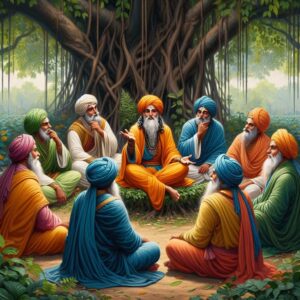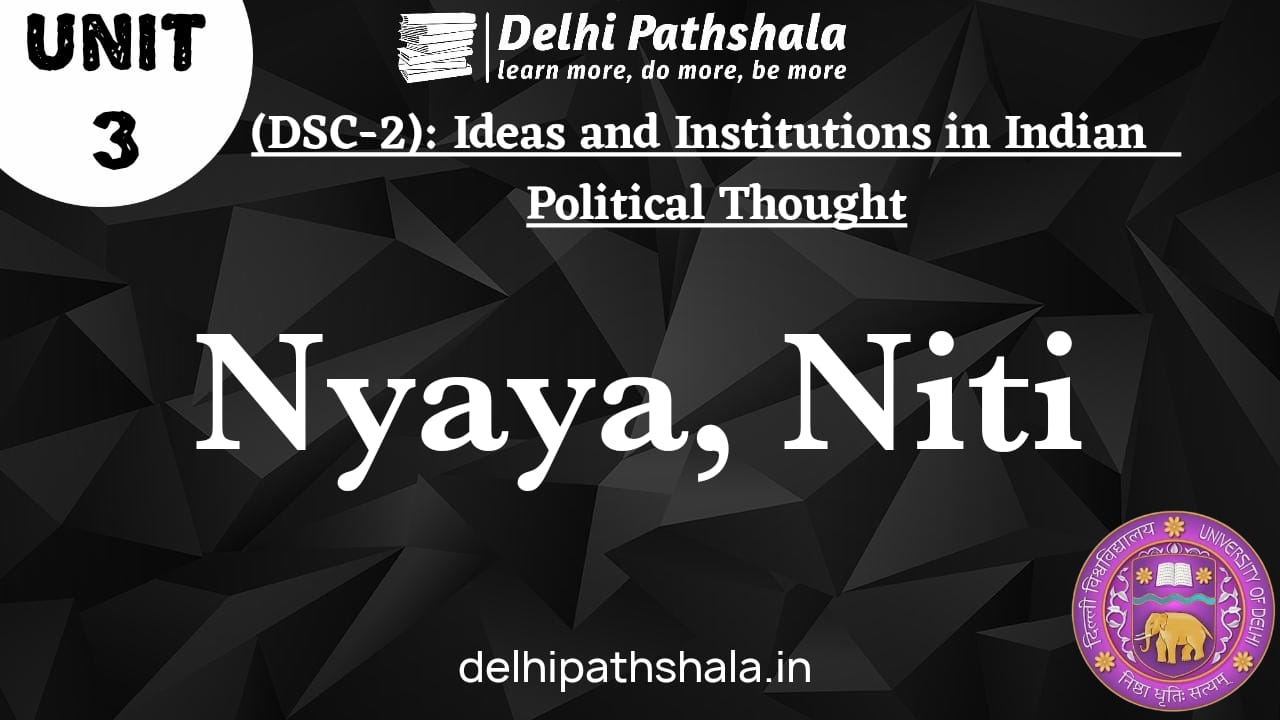Nyaya and Niti in ancient Indian political thought:
In ancient Indian political thoughts, Nyaya and Niti are very important. They give us understanding about the moral and practical sides of ruling.
1. what is Nyaya:
Meaning: Nyaya means justice or fairness. It is about the moral rules that guide how we live together in society. It focuses on fairness, equality, and following ethical guidelines. Nyaya is based on Dharma, which is about moral order in Hindu beliefs.
Implications: For rulers and leaders, Nyaya means they must act with justice and fairness in their decisions. It highlights the importance of good behavior, honesty, and caring for the people. It suggests that political power should be used according to moral values to benefit society.

2. what is Niti:
Meaning: Niti means political strategy or policy. Unlike Nyaya, which is more about ethics, Niti looks at the practical side of ruling, such as political methods, diplomacy, and managing the country well.
Implications: Niti understands that politics can be complicated and requires skilled management. It includes making rules, handling relationships with other countries, military strategies, and managing the economy. Niti recognizes that politics can change and that leaders need to adapt to new situations.
Nyaya and Niti are different ideas, but they work together. A good leader should use both ethical rules (Nyaya) and practical strategies (Niti) in their leadership.
This means making choices that are not only smart politically but also fair and right. Political actions should match moral values to help society stay stable and healthy.
| Related | |
|---|---|
| Rajya and Rashtra in ancient India | Dharma Dhamma and Danda notes |
Interplay among Nyaya and Niti:
The idea of “Dandaniti” shows how Nyaya and Niti connect. It combines justice (Nyaya) with the need for rules and order. This idea highlights the need for a fair legal system and strong law enforcement to keep social order.
In summary, Nyaya and Niti in old Indian political thought represent two sides of governance. Nyaya is about morality and fairness, while Niti focuses on political strategy. Combining both is important for good and ethical leadership.

How did Nyaya, Niti concepts shape the political and social order of ancient India: –
Concept of nyaya in ancient india
- Shaping Political Order:
Nyaya was important in shaping the political system of ancient India by providing a moral basis for how to govern.
Rulers were expected to follow Nyaya principles when making decisions. The idea of Dharma, closely linked to Nyaya, guided political leaders.
Dharma focused on doing the right thing, justice, and caring for the people, which helped create fair governance.
- Social Implications:
Nyaya helped create a fair society by promoting equality. It encouraged a just and peaceful community where people were expected to fulfill their roles according to moral values.
Nyaya also influenced legal systems, stressing the need for a fair and unbiased court system. Laws and institutions were expected to uphold justice and protect people’s rights.
- Ethical Leadership:
Rulers were encouraged to practice ethical leadership by making choices that aligned with Nyaya. The goal was to create a political environment that put the people’s welfare first, rather than personal gain or power.
Nyaya urged rulers to think about how their actions affected society and to lead with a sense of responsibility for the well-being of their people.
| Related | |
|---|---|
| Statecraft in Ancient India | Sabha and Samiti notes |
Concept of Niti in Ancient India:
- Strategic Governance:
Niti played an important role in shaping the government of ancient India by focusing on smart leadership. It understood that there were many political views and that leaders needed to use good methods and rules to keep things stable.
The Arthashastra, written by Chanakya, is a key work that talks about Niti, giving advice on military strategy, diplomacy, economic policies, and how to run the government.
- Diplomacy and Foreign Relations:
Niti also affected how rulers dealt with other countries. Ancient Indian leaders used diplomacy, made alliances, and held talks to protect their kingdoms. Niti provided a guide for wise decision-making in international matters. The idea of “Sama, Dana, Bheda, Danda” (peace, gifts, division, and force) in the Arthashastra shows the strategic ways to manage outside powers.
- Administrative Efficiency:
Niti helped improve how the government worked by advising rulers on good governance. It covered issues like taxes, law and order, building infrastructure, and managing resources. The goal of applying Niti was to ensure the nation’s stability and prosperity by giving practical advice for rulers to handle the kingdom’s internal matters.
In summary, the ideas of Nyaya and Niti together formed the political and social order of ancient India. Nyaya focused on justice and ethics in governance, while Niti emphasized smart leadership and practical policies to maintain stability and prosperity. The combination of Nyaya and Niti was seen as essential for effective and fair governance in ancient India.
Political ideologies and practices of different schools of thought, such as the Brahmanical, Buddhist, Jain, and Lokayata traditions: –
The ideas of Nyaya and Niti greatly influenced the political beliefs and actions of different groups in ancient India, such as the Brahmanical, Buddhist, Jain, and Lokayata traditions. Each group understood and used these ideas in their own ways. Here’s a summary of their influence:
Brahmanical Tradition:
- Nyaya Influence:
– Dharma and Just Rule: In this tradition, Nyaya shaped the idea of Dharma, stressing that rulers should act rightly. The Manusmriti explains the duties of rulers to ensure justice and moral order in society.
- Niti Influence:
– Arthashastra: During the later Vedic period, this tradition used the practical governance ideas from the Arthashastra, written by Chanakya. This text offered advice on running a state, diplomacy, and management, fitting with Niti ideas.
Buddhist Tradition:
- Nyaya Influence:
– Righteous Governance: Buddhism, which values compassion and nonviolence, included Nyaya ideas in its political views. The idea of just rule, focused on ethics and care for everyone, aligns with Buddhist beliefs about governance.
- Niti Influence:
– Diplomacy and Ahimsa: Buddhist leaders often followed Niti ideas in their diplomacy. They practiced nonviolence (ahimsa) and smart tactics in war, reflecting the strategic governance from Niti.
Jain Tradition:
- Nyaya Influence:
– Ahimsa and Just Rule: Jain political thought stresses ahimsa (nonviolence) and anekantavada (many-sidedness). Nyaya guided Jain ideas about just rule, highlighting the importance of avoiding harm and promoting well-being.
- Niti Influence:
– Diplomacy and Non-Aggression: Jain rulers, following Niti ideas, used diplomatic methods that favored peace and non-aggression. Their focus on moral behavior and peaceful approaches matched Niti principles.
Lokayata (Charvaka) Tradition:
- Nyaya Influence:
– Materialistic Ethics: The Lokayata tradition, known for its materialistic and atheistic views, had a unique ethical basis. Nyaya ideas might not be clear here, as the focus was more on practical and material well-being.
- Niti Influence:
– Pragmatic Governance: The Lokayata tradition, being practical and doubtful of spiritual ideas, likely adopted governance methods based on real observations and practical concerns. Niti ideas could fit with a more practical and useful approach.
General Trends:
- Common Moral Ideas:
Even with different beliefs, there were shared ideas about morality from Nyaya across traditions, which focused on justice, doing the right thing, and helping people.
- Fit for Culture:
Each tradition adapted Nyaya and Niti ideas to fit its own culture and philosophy, leading to different ways these ideas were understood and used in politics.
In short, Nyaya and Niti ideas shaped the political thoughts and actions of different groups in ancient india, giving a moral and practical foundation for governing. The way these ideas were understood was influenced by the unique beliefs and cultures of each group.
How did these concepts relate to the notions of justice, law, and morality in ancient India?
In ancient India, the ideas of Nyaya and Niti were very important in shaping what people thought about justice, law, and morality. These ideas were part of the culture, religion, and philosophy of the time, affecting how people acted and how they were governed.
Nyaya and Notions of Justice, Law, and Morality:
Nyaya and Notions of Justice:
- Ethical Foundation: Nyaya was closely linked to Dharma, which means it helped create the moral basis for justice. It stressed the importance of doing the right thing in all areas of life, including in government.
- Equality and Fairness: Nyaya supported fairness and equality. It promoted the idea that everyone should be treated equally in matters of justice, regardless of their social status or background.
- Legal Implications: Nyaya influenced the legal system by helping to create laws that were based on moral values. It aimed to protect people’s rights and keep social order through ethical principles.
- Dandaniti: This idea, connected to Nyaya, focused on punishment that aligned with Dharma. Punishments were not just for revenge but were meant to restore moral balance.
Nyaya and Law Ideas:
- Dharma Shastra:
Legal Rules: Nyaya ideas are written in important texts like the Manusmriti and other Dharma Shastras. These texts included laws that guided social and political life, providing a system for criminal justice.
- Court Processes:
Fair Judging: Nyaya influenced court methods, highlighting the need for fair judging. Judges are expected to use Nyaya ideas to solve disputes and deliver justice without bias.
- Rights and Responsibilities:
Legal Rights: Nyaya helped in recognizing individual rights within the law. Legal rights were seen as part of moral rights, and the legal system aimed to protect these rights while also stressing personal responsibilities
Nyaya and Ideas of Morality:
- Right Behavior:
Personal Morality: Nyaya stressed the importance of good behavior in people’s lives. Following moral rules was not only a social duty but also a way to achieve spiritual well-being.
- Dharma and Moral Balance:
Universal Morality: Nyaya connected personal morality with universal morality, or Dharma. Following moral standards was viewed as being in tune with nature and helping to create overall moral balance in the universe.
Niti and Ideas of Justice, Law, and Morality:
- Practical Leadership:
Niti focused on practical ways to deliver justice. It recognized that justice should be applied carefully to maintain social balance and help the country.
- Fair Diplomacy:
Niti encouraged fair diplomatic practices, understanding the importance of moral issues in international relations. Diplomacy was expected to follow moral values while also aiming for strategic goals.
- Ethical Leadership:
Niti advised leaders to have strong moral values. While strategy was important, leaders were expected to act responsibly to ensure the well-being of their people.
In summary, Nyaya and Niti were key to understanding justice, law, and morality in ancient India. Nyaya provided a moral foundation for justice and law, while Niti focused on practical governance, ensuring that decisions were aligned with moral values. Together, these ideas created a strong system that guided the legal and ethical standards of ancient Indian society.
How did these concepts evolve and change over time in response to historical and cultural developments? –
The ideas of Nyaya and Niti in ancient Indian political thought changed over time due to history, culture, and philosophy. They developed from early Vedic rituals to modern laws, adapting to different political situations. This shows how important they are in shaping political ideas and rules. The growth of Nyaya and Niti shows how Indian thought has changed with the times. Here is a closer look at how Nyaya and Niti changed over time:
Early Vedic Period:
- Nyaya:
Ritual Ethics: In the early Vedic time, Nyaya was linked to ritual ethics, focusing on performing religious rites and following duties to maintain righteousness.
- Niti:
Tribal Governance: Niti during this time was likely more about tribal governance and maintaining social order in small groups. Leadership relied on customs and tribal chiefs.
Later Vedic Period:
- Nyaya:
Dharma Codification: In the later Vedic period, Dharma was organized in texts like the Manusmriti. Nyaya became more structured, offering clear rules for moral behavior and justice, beyond just rituals.
- Niti:
Statecraft Development: As more complex governments arose, Niti became important. The Arthashastra by Chanakya provided insights into statecraft, diplomacy, and practical governance, helping rulers manage their kingdoms.
Mauryan and Gupta Empires:
- Nyaya:
Law Codification: During these empires, laws were organized, and legal systems were established. Nyaya influenced legal codes, emphasizing justice and individual rights.
- Niti:
Diplomacy Growth: The Mauryan Empire, led by Chandragupta Maurya and Ashoka, used diplomatic methods based on Niti. Ashoka’s focus on dhamma (righteousness) in his edicts combined ethical governance with strategy.
Post-Gupta Period:
- Nyaya:
Philosophical Influence: Different philosophical schools, including Nyaya, emerged as unique traditions. Nyaya engaged in debates with others, shaping its interpretations in politics and ethics.
- Niti:
Governance Changes: Political splits and local kingdoms led to different governance styles based on Niti. Local rulers adapted Niti ideas to their specific contexts.
Medieval Period:
- Nyaya:
Bhakti Movement Connection: In the medieval period, Nyaya ideas merged with Bhakti movements. Devotion and ethics were linked, with Nyaya providing a philosophical base for ethical living in devotional practices.
- Niti:
Sultanates and Rajput Kingdoms: The medieval political scene saw Islamic governance through sultanates. Rajput kingdoms also adapted Niti ideas to manage political challenges.
Mughal Period:
- Nyaya:
Sufi Thought Influence: Nyaya concepts influenced by Sufi thought were important during the Mughal period. The focus on moral conduct and justice continued, especially with Akbar’s efforts to combine different religious and ethical traditions.
- Niti:
Akbar’s Governance Reforms: Akbar’s reforms showed a deep understanding of governance, using Niti ideas. His focus on inclusive governance and efficiency reflected a practical approach.
Colonial Period:
- Nyaya:
British Legal System: During colonial times, British rulers organized laws based on Nyaya ideas but also included Western legal concepts. The Indian Penal Code and the Code of Criminal Procedure were introduced, changing the legal landscape.
- Niti:
Western Political Influence: British practices and Western political ideas began to shape Niti concepts. New ideas led to changes in administrative methods.
Post-Independence Period:
- Nyaya:
Indian Constitution Impact: Nyaya ideas influenced the Indian Constitution’s ethical foundations. Justice, equality, and individual rights are rooted in Nyaya, providing a base for the legal system.
- Niti:
Democratic Governance: Niti concepts still play a role in democratic governance, focusing on strategic decisions and diplomatic relations in a modern context.
Contemporary Period:
- Nyaya:
Human Rights Focus: Nyaya ideas continue to influence discussions on human rights and social justice, addressing issues like environmental ethics and gender justice.
- Niti:
Globalization and Diplomacy: In modern times, Niti ideas adapt to globalization and interconnectedness, managing complex international relations and technological changes.
In summary, the ideas of Nyaya and Niti in ancient Indian political thought evolved over time, responding to historical and cultural changes. From early Vedic rituals to today’s constitutional framework, these concepts adapted to various political situations, showing their ongoing importance in shaping political ideas and governance.
read more:
IDEAS AND INSTITUTIONS IN INDIAN POLITICAL THOUGHT


